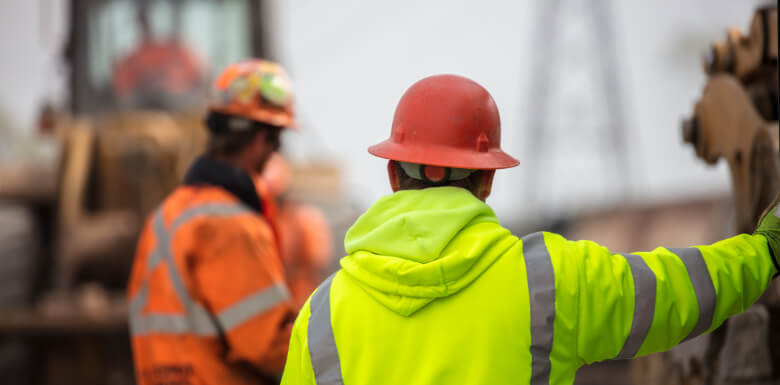If you work in construction, wearing a hard hat is more than a precaution—it’s a necessity. Hard hats protect against flying or falling objects, electric shocks, and burns. Failing to wear one can lead to life-altering injuries, making it harder to return to work or enjoy the quality of life you deserve.
If you’ve been injured in a construction accident, the experienced New York construction accident lawyers at Hecht, Kleeger & Damashek, P.C., are here to help. Contact us today at (212) 490-5700 or use our online contact form to learn your legal options and safeguard your rights.
What Is a Hard Hat?
A hard hat is a protective helmet designed to shield construction workers from head injuries caused by falls, blunt or sharp object impacts, and electrical hazards. According to the Occupational Safety and Health Administration (OSHA), hard hats must have:
- A hard outer shell for durability
- A shock-absorbing lining with a headband
- Water resistance and burn resistance
- The ability to absorb impact and resist penetration by falling objects
Some hard hats come with advanced features like built-in visors, earmuffs, and headlamp attachments for added protection and functionality.
Hard Hat Classes
OSHA categorizes hard hats into three distinct classes based on the level of protection they offer:
Class G (General):
- Protection against impact and penetration.
- Voltage protection up to 2,200 volts.
- Suitable for most general construction sites where low-voltage electrical exposure is possible.
Class E (Electrical):
- The highest protection against electrical hazards, up to 20,000 volts.
- Ideal for electricians or workers exposed to high-voltage environments.
Class C (Conductive):
- Provides basic impact protection but no defense against electrical hazards.
- Often lighter and more ventilated, making them suitable for environments without electrical risks.
Each class may come in different styles, such as full-brim designs for better sun protection or cap-style for enhanced visibility and compatibility with other safety gear.
Choosing the Right Hard Hat
Selecting the correct hard hat is just as crucial as wearing one. Consider these factors when making your choice:
- Work Environment:
-
- For jobs involving high-voltage electrical risks, choose a Class E hard hat.
- A Class G hard hat may suffice if electrical exposure is minimal but possible.
- A lightweight Class C hard hat could provide comfort and impact protection if no electrical hazards are present.
- Fit and Comfort:
-
- Ensure the hard hat fits snugly but comfortably without shifting.
- Adjustable headbands and suspension systems help achieve the perfect fit.
- Durability:
-
- Look for models made from high-quality materials resistant to cracking, fading, and wear.
- Maintenance:
-
- Inspect hard hats regularly for cracks, dents, or other signs of wear.
- Replace any damaged or aged hard hats, as they may no longer provide adequate protection.
Are Hard Hats Required on Construction Sites?
Yes, hard hats are mandatory on construction sites. Both OSHA and the New York City Department of Buildings require construction workers to always wear hard hats to mitigate the risk of head injuries.
Employer Responsibilities:
- Provide hard hats that meet safety standards.
- Ensure workers are properly trained on when and how to wear hard hats.
- Enforce consistent use of hard hats on job sites.
Why Compliance Matters:
Head injuries are one of the leading causes of fatalities on construction sites. In many cases, these injuries are preventable with proper protective gear. Workers who neglect to wear hard hats or wear damaged ones are at greater risk for severe trauma, including concussions, skull fractures, and brain injuries.
Worker Safety Tips:
- Always check your hard hat for damage before use.
- Replace hard hats that have sustained an impact, even if no visible damage is present.
- Store hard hats in a cool, dry place to prolong their lifespan.
Additional Safety Tips for Construction Workers
Hard hats are just one piece of the safety puzzle. Follow these additional tips to reduce your risk of injury:
- Attend safety training sessions: Participate in all employer-hosted safety programs. These sessions can teach life-saving practices and precautions.
- Wear proper protective gear: High-visibility clothing, steel-toed boots, goggles, and protective suits are essential for overall safety.
- Inspect tools and equipment: Before using machinery and tools, always ensure they are in good working order to avoid accidents.
Injured on a Construction Site? Contact Hecht, Kleeger & Damashek, P.C.
If you’ve been hurt in a construction accident, let the team at Hecht, Kleeger & Damashek, P.C., fight for your rights. We’ll assess your case and help you pursue the maximum compensation you deserve. Call (212) 490-5700 today or reach us through our online contact form.

